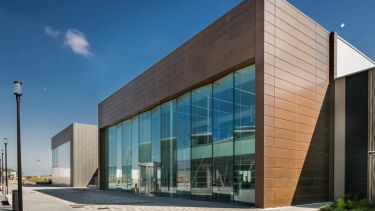Advanced Characterisation to Understand Radiation Damage in Materials
Advanced Characterisation to Understand Radiation Damage in Materials is a key research activity for the Henry Royce Institute.

Advanced Characterisation to Understand Radiation Damage in Materials
Our world-leading facilities - Royce Discovery Centre and Royce Translational Centre - are just an element of the extensive novel characterisation facilities offered across the Royce partnership.
The Advanced Characterisation to Understand Radiation Damage in Materials Technology Platform brings together the extensive novel characterisation facilities offered across the Royce institutes with state-of-the art active materials development, in order to investigate radiation damage in active and non-active inorganic materials.
The objective of this technology platform is to facilitate development of materials for the next generation of fission and fusion power stations, and realise the Royce ambition to develop vibrant industry- and academic-led programmes which accelerate nuclear’s contribution to decarbonisation.
Radiation damage in materials for nuclear power can take on many forms. Neutron irradiation can displace atoms in a material leading to changes in crystal-, micro-, and nano-structures, as well as result in transmutation leading to a change in material composition and the production of the transmutation gases, helium, and hydrogen.
For alpha-emitting waste materials, the alpha-daughter recoil nuclei induce high levels of atomic displacements and the alpha-particle can induce chemical changes by ionisation and excitation processes in materials before eventually transforming into helium. The surface of plasma-facing materials for fusion can change due to plasma-surface interactions, resulting in surface nano-structuring, erosion, and tritium retention.
This technology platform enables examination of all of these radiation induced damage effects.
To develop materials for the next generation of fission and fusion power stations, characterisation of radiation damage in non-active materials is often first undertaken in order for a wide range of materials to be surveyed without the need for active handling capabilities.
Energetic ion implantation is a method commonly used to induce atomic displacements and gas production analogous to neutron- and alpha-irradiation, without generally rendering the material radioactive. However, ion implantation often only damages the surface of materials, up to about a micron.
Within Royce, we have the capabilities to probe only this damaged surface region. For example, to determine any implantation induced changes to crystal structure (including structural units in amorphous materials such as nuclear waste glass analogues) we offer X-ray diffraction (XRD) in grazing incidence and UV Raman spectroscopy.
We can utilise transmission electron microscopy, including atomic-scale resolution capabilities, and electron probe microanalysis (EPMA) for the characterisation of implantation-induced defects, including secondary phase and gas bubble formation and elemental segregation, and offer site specific plan-view and cross-sectional sample preparation.
The next stage in nuclear materials development is in producing and characterising active materials. This technology platform includes state-of-the-art equipment and instrumentation for materials formulation, processing, characterisation, and performance assessment of active materials comprising α and β, γ nuclides, including solid-state plutonium.
Processing of these active materials can be carried out via conventional solid state synthesis using our suite of high temperature furnaces, or by using the UK’s only radiological Hot Isostatic Press operating up to 2000 ℃ and 200 MPa. This technology platform houses extensive active material characterisation facilities, including diffraction and spectroscopy (e.g., XRD, Raman, X-ray absorption and emission spectroscopy), microscopy and microanalysis (e.g., atomic force microscopy, optical profilometry, and EPMA), Thermal and physicochemical analysis and Chemical and radiochemical analysis.
More information on the radiological Hot Isostatic Press can be found in our brochure, available to download here.
Advanced Characterisation to Understand Radiation Damaged Materials encompasses multiple areas.
Download our infographic for more context here.
Technology Platform Lead: Dr Amy Gandy
Amy Gandy is Senior Lecturer in Nuclear Materials Engineering, and previously held a Royal Academy of Engineering / Leverhulme Trust Research Fellowship in Understanding Radiation Damage Mechanisms in Novel, Compositionally Complex Alloys.
Amy completed a joint PhD at the University of Salford and the University of Poitiers, France, in 2009 for which she used transmission electron microscopy (TEM) to understand ion beam implantation induced defect formation and interactions during thermal annealing in crystalline and amorphous silicon, relevant to the semiconductor industry.
Her current research focuses on new materials development for fusion, and radiation-induced damage and recovery mechanisms, and gas bubble formation, in poly-crystalline oxide-based materials and compositionally complex alloys for both fission and fusion, in collaboration with the UK Atomic Energy Authority (UKAEA), National Nuclear Laboratory (NNL), and Atkins Global.




